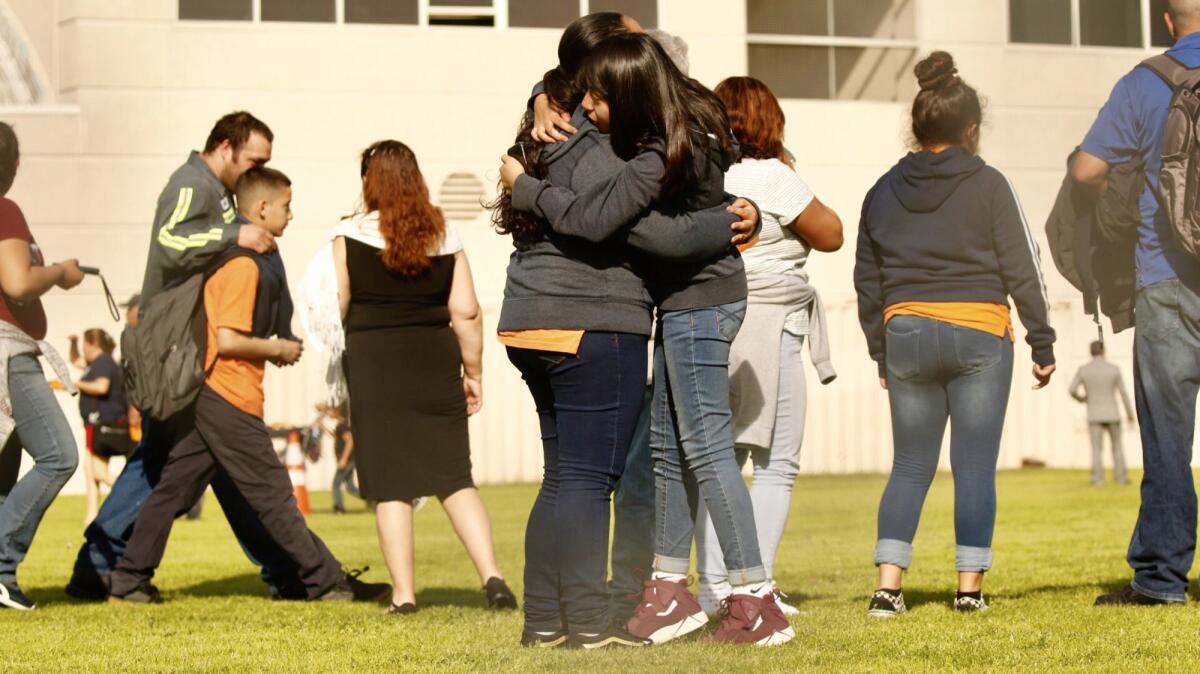Q&A: What exactly does L.A. Unified do to try to prevent school shootings?

Gunfire erupted in a classroom at Sal Castro Middle School on Thursday morning. Two 15-year-olds were hit — one in the head. A 12-year-old girl was taken into custody.
The incident immediately revived an ongoing debate about how best to keep students in the Los Angeles Unified School District safe.
The nation’s second-largest district relies on both policing and counseling to try to prevent campus violence. It also has an experienced team of counselors to deal with the aftermath — although most deadly episodes happen outside school.
Does this episode represent a failure of the school or the L.A. school district?
Not necessarily. The pervasiveness of guns and the many ways to get a gun on campus — such as passing it through a fence — make preventing all potential violence an impossibility. But L.A. and school police are trying to determine what went wrong and if mistakes by adults contributed to Thursday’s shooting. Such mistakes could include family members failing to secure a gun at home.
How are L.A. schools kept safe?
The short version? A combination of hardware, policing and counseling.
The hardware includes fencing and metal-detecting wands for what are supposed to be daily random checks of students and their belongings at all middle schools and high schools. The policing includes armed officers at these schools. The counseling notably includes a recent expansion of an approach called restorative justice, which uses group and individual discussions to teach students how to defuse conflicts and take responsibility for their actions. Many staff members at schools, including teachers, play a role in counseling and mentoring, whether through restorative justice or daily contact with students.
How well are these measures working?
School shootings are rare, and schools generally are safer than the neighborhoods they’re in. More typical problems at schools include bullying, drug use, vandalism, ditching class and classroom disruption.
All the preventive strategies in use also have limitations — and critics.
The problem with fencing, armed officers and daily random searches is that they can make schools feel like prisons — which some point out is hardly conducive for learning and emotional growth. If they contribute to student alienation, they could wind up exacerbating campus confrontations. All the same, some parents would like to see more armed officers, especially those who are supportive of students. And some people don’t like that many schools don’t appear to be conducting the searches daily.
The problem with counseling is that schools rarely provide enough. Questions also have been raised about whether staff have been trained effectively in the district’s newer approaches. In some cases, moves to supplant traditional discipline — including suspensions — with counseling have backfired, leading to increases in classroom disruption.
In neighborhoods distressed by high crime and poverty, of course, preventing all violence is not a job that schools realistically can do on their own.
What is the history of shooting incidents at L.A. schools, and what has been the response to them?
The district started conducting random searches in 1993 after a 16-year-old was shot and killed at Fairfax High School. A month later, a student died in a shooting at Reseda High School.
The district began requiring daily searches with metal-detector wands in 2011 after two students were injured in a shooting at Gardena High School.
Are the district’s random searches working?
There’s debate over this. A recent analysis of district records over a two-year period turned up no recorded incidents of guns being found during a random search. The searches did, however, turn up some other illegal or dangerous objects, such as knives. Opponents of searches cite the lack of guns as proof of the futility and unfairness of the process. Officials who favor searches cite these same numbers as evidence of success, on the grounds that they have deterred students from bringing in weapons.
With or without the searches, weapons have been found on campuses and on students. From July 1, 2014, to June 30, 2017, staff and school police confiscated 70 handguns, 16 rifles/shotguns, and 1,196 knives, according to data provided by board member George McKenna.
Separate from the current debate over the wisdom of random searches is the question of whether the district is following its own policies in carrying them out. The searches are supposed to happen every day and in every secondary school. And they’re supposed to be truly random — with no profiling by race or any other characteristic.
A district audit and a review by outside researchers found that the district is keeping inadequate records of its searches and that the methods and frequency of the searches vary greatly from place to place.
Start your day right
Sign up for Essential California for news, features and recommendations from the L.A. Times and beyond in your inbox six days a week.
You may occasionally receive promotional content from the Los Angeles Times.




